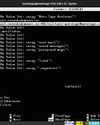Making Git so easy, we say it's Magit!
Linux Format
|March 2023
Aaron Peters uses the Emacs Git client Magit to perform a long overdue update of his LXF repository.

OUR EXPERT
Aaron Peters is a long-time Linux user, but still quite the Emacs neophyte. Nothing a few decades' more experience won't fix. In the meantime, being a software designer will have to suffice.
QUICK TIP
If you're interested in Magit but not Emacs, add the following to the end of the -/.emacs.d/ init.el file after installing to launch straight into Magit: (require 'magit) (magit-status)
Git was developed as a tool to manage the development of code by teams, including versioning and collaborating. In other words, a tool for developers. But its use is now so pervasive in the open source world that most serious users of Linux should be able to use it. While you may not write software, some applications' authors provide it for installation by cloning the repository. Additionally, participating in online projects may require you to make your contributions (see LXF298 for a summary of non-code input) to a GitHub or GitLab repository.
But Git is a sizable application, with lots of subcommands and options. If you're simply a studious Linux user, rather than a developer or sysadmin, you may not be called upon to use it every day. The learning curve can therefore be pretty steep. This article will introduce Magit, an Emacs package that provides what some call the best GUI for Git. Let's get started.

Why Magit?
Magit (https://magit.vc) is a package for Emacs written in Lisp, so you need to install Emacs to use it. But why use this compared to some of the other GUI apps for Git? There's a couple of compelling reasons.
Denne historien er fra March 2023-utgaven av Linux Format.
Abonner på Magzter GOLD for å få tilgang til tusenvis av kuraterte premiumhistorier og over 9000 magasiner og aviser.
Allerede abonnent? Logg på
FLERE HISTORIER FRA Linux Format

Linux Format
Create your first WebSocket service
Mihalis Tsoukalos explains how to use the Go programming language to work with the WebSocket protocol.
9 mins
April 2023

Linux Format
Fantastic Mr Firefox
Nick Peers takes a trip down memory lane to reveal the story behind the rise - and slight fall - of Mozilla's popular web browser.
9 mins
April 2023

Linux Format
Set up your terminal and email like it's 1983
Jump in the hot terminal time machine with Mats Tage Axelsson who emails from the command line using the latest technology.
8 mins
April 2023

Linux Format
Universal layer text effects with GIMP
Posters use them, films and presentations are hard to imagine without them: text effects. Attract attention with Karsten Günther and GIMP.
8 mins
April 2023

Linux Format
Jump to a federated social network
Nick Peers reveals how you can get up and running with this free, decentralised and non-profit alternative to Twitter.
9 mins
April 2023

Linux Format
Free our SOFTWARE!
Taking anything for granted is dangerous, so Jonni Bidwell and Mike Saunders revisit how the free software movement got started to help free us from proprietary tyranny!
4 mins
April 2023

Linux Format
Master RPI.GPIO
Les Pounder goes back to the early days of the Raspberry Pi - and his career with this classic library! -
5 mins
April 2023

Linux Format
Waveshare Zero to Pi3
Transform your Pi Zero into a Pi 3, they promised Les Pounder, but it's more like adding on go-faster stripes.
2 mins
April 2023

Linux Format
The Best OPEN SOURCE Software Ever!
In an attempt to trigger controversy, Michael Reed and Neil Mohr unequivocally state these are the greatest free software apps ever. Probably. We’re just trying to be helpful.
19 mins
April 2023

Linux Format
Linux-Mandrake 7
Simplicity and a wide range of applications make this a great distribution for all Linux users.
2 mins
April 2023
Translate
Change font size

